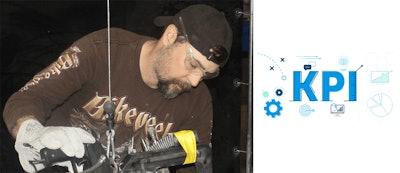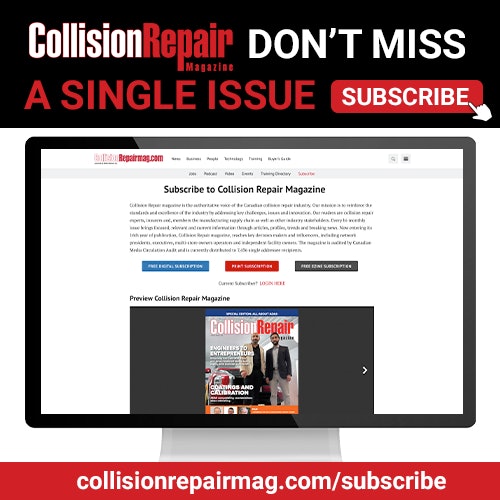
By Kelly Roberts
North Bay, Ontario — Handling high volumes of business can be a bit like lifting heavy weights. A significant amount of volume is good—if you have the bulk to handle it. In fact, it is a clear sign that your business is doing something right. It feels amazing!
And just like weightlifters, businesses that receive too much volume without a solid support-system, will be crushed. That doesn’t feel so amazing.
Over the past 10-to-20 years, as efforts to build-up the volume-of-business have allowed some shops and networks to grow enormously and rapidly, the ability for the supply chain workers (shops) to handle these increases hasn’t always been fortified enough to keep up.
For one thing, some businesses that have been able to grow their volume have done so by appealing almost exclusively to the auto insurance sector and certain Key Performance Indicators (KPIs). As a result, our industry has started treating appeasing insurers KPIs as the primary goal of any successful business. In fact, the fear of being throttled by insurers for bad KPIs is so great that collision facilities will tie themselves in knots in order to preserve their reputation with insurers. Some don’t even blink at absorbing the cost of repair supplementals!
I recently consulted with an auto repair network that was “being hammered by an insurer” for its network’s average vehicle rental overages (based on the estimated length-of-rental) to the point of losing that key account to a competing network.
One look at some estimation sheets and I knew why.
The estimates were terrible.
Lots of required operations were missing and, ultimately, the shop would have to perform these operations and conduct additional labour.
In layman’s terms: when the shop would have to perform, say, eight days of repairs, their schedule sheet only accounted for half of the time the job would take in reality.
It was easy to see that this was not a sustainable practice. Left off of the sheet, this extra work was not going to have a positive effect on LOR—it did the opposite!
It wasn’t that the estimators themselves were bad, it is too often that they are under enormous influences and pressure to work quickly, rather than to develop the safe and proper repair plans in a complete manner.
Supplemental work—another negative KPI—was frequently required. Repair scheduling was thrown completely out-of-whack (yet another).
In short, intense pressure without proper support was producing consistently inefficient, over-cost repairs of poor quality.
The business is not the only one to find itself being hamstrung for the same reason—having more volume than can safely manage. It is an issue that occurs at many top-heavy organizations, and it only serves to prime them for catastrophic, instant collapse.
It is easy to understand the basic thinking behind the model.
Insurers and clients, after all, do not cover that period—so why invest more into it? Why allow customers to wait around any longer than is strictly necessary? Who really wants to wait for anything anymore—or to pay?
In our eagerness to build volume, we take steps to appeal to customers and insurers, but at what cost?
On the front-end, this means we rush through the estimation and repair planning phases.
On the back end, however, this means we aren’t just approaching repairs in the wrong way, we are actively missing out on accounting for the actual work required—and most often exclusively paying for the privilege.
In some situations, the industry doesn’t struggle with those sorts of equations. No one would think that a brand of sandpaper that costs half as much as a competing brand—and requires twice as much to be used—is saving them money.
Sure, when it comes to overall operations, the math is more difficult. It can’t be fully quantified due to various collateral effects that are not easily accountable. But a rough estimate shouldn’t be impossible!
If you take a step back, it is obvious that there is a problem with the whole model here. The truth is, though, that whether or not front-end work is paid for directly is an irrelevance to a business. Whether it is being done efficiently is what matters—and efficiency doesn’t mean done in haste!
As it is often said, often said, “Do you want it done right, or done right now.” Choose carefully, one is done and the other is never really done.
I say: everything that has to happen will happen. Our opportunity, here, is to control when it happens in order to produce 100 percent correct, first-time results. Why? Because a job done one percent wrong can, and will, completely destroy the other 99 percent of work done right.
I call it the one percent rule.
Do I have proof this is the right approach? Yes. I bet you do too!
Remember that job you did and the client found one little thing? Then, that one thing snowballed and snowballed until the work needed to fix it wend out-of–control?
Deja-vu, anyone?
Would spending more time investigating damage and drafting up damage blueprints, researching repair plans built off of dedicated repair procedures cut down on the total amount of time spent on repairs? Almost certainly.
I know of several businesses that have an almost even ratio of trained front-end workers to back-end workers.
One shop owner remarked that the business could possibly break even if they could find an average of between $100 to $150 on each job.
The pressure needs to be taken off the front end, it needs to be relaxed in order for the back end to perform its work safely and effectively.
Currently, we race through estimations in order to keep the customer happy. The price? Bad KPIs.
When we find we’ve missed something, we pay for it ourselves in order to keep them and the insurers happy. We absorb the cost, we accept even worse KPIs.
In this business, we are so paranoid and pressurized about not meeting certain KPIs that auto repair facilities don’t even blink at absorbing the cost of a repair supplemental to those originally submitted to insurers to avoid the fallout of losing volume.
Don’t get me wrong, customers and insurers really should be covering the cost of performing safety-driven repair planning and proper estimation work.
It is high time to support the business areas and front end processes that will produce the results we all want and need.
The outcome of finally properly supporting this area-of-business (its too often neglected foundation) will prove dramatic KPI Improvement—and that is with all recent industry changes considered.
If the time is properly accounted for on LOR agreements, it wouldn’t just benefit collision facilities. It would be good for insurers, and it would be good for their customers.
Until we all get our act together, there’s absolutely too much being left on the table. For the repair facilities daring enough to get things right from the start, it is up for grabs!
__________________________________________________
Involved in the collision sector since 1989, Kelly Roberts is a vice president of sales at AirPro Diagnostics. During the course of his career, in which he has been involved in many areas of the collision sector, team member, employee and owner/manager, Roberts been an advocate for the improvement of the collision repair industry as-a-whole. He previously served on the Axalta National Business Council under Tom Parnell and Mike Anderson.






















